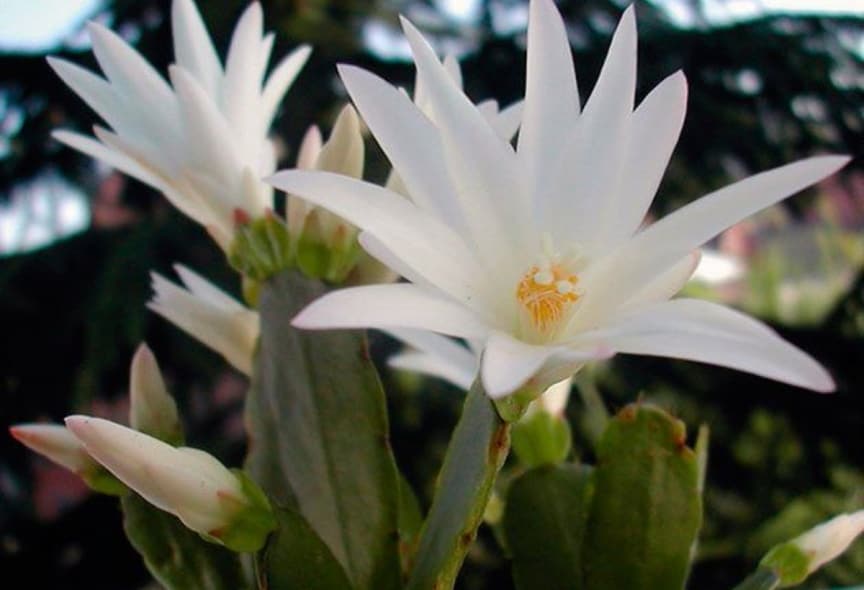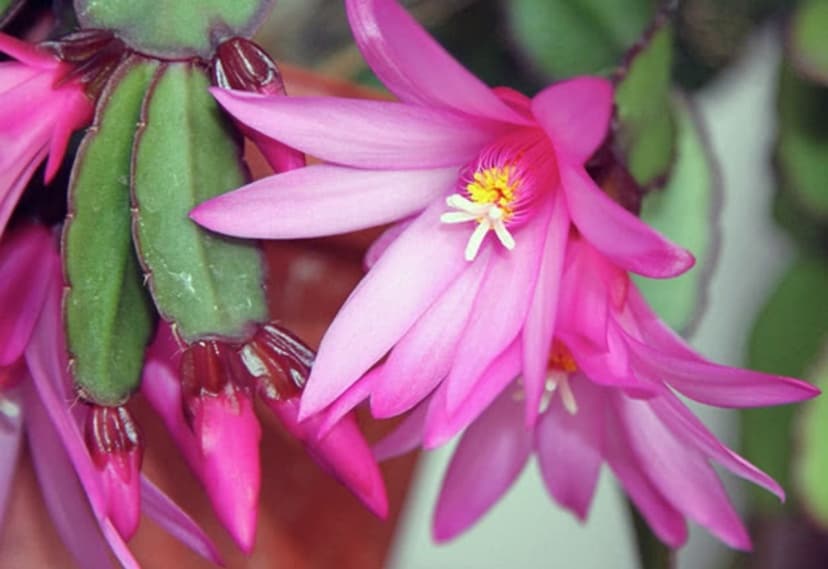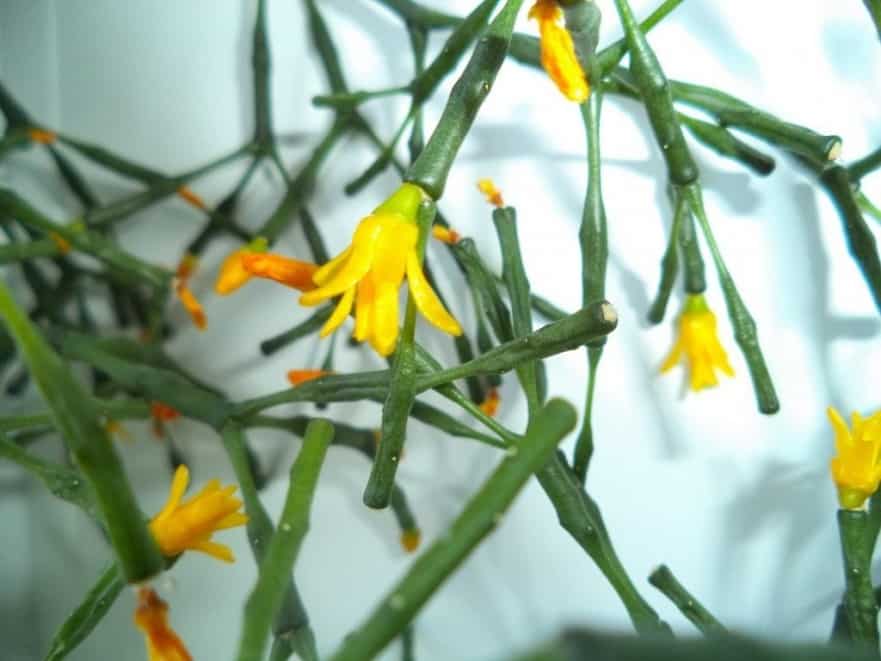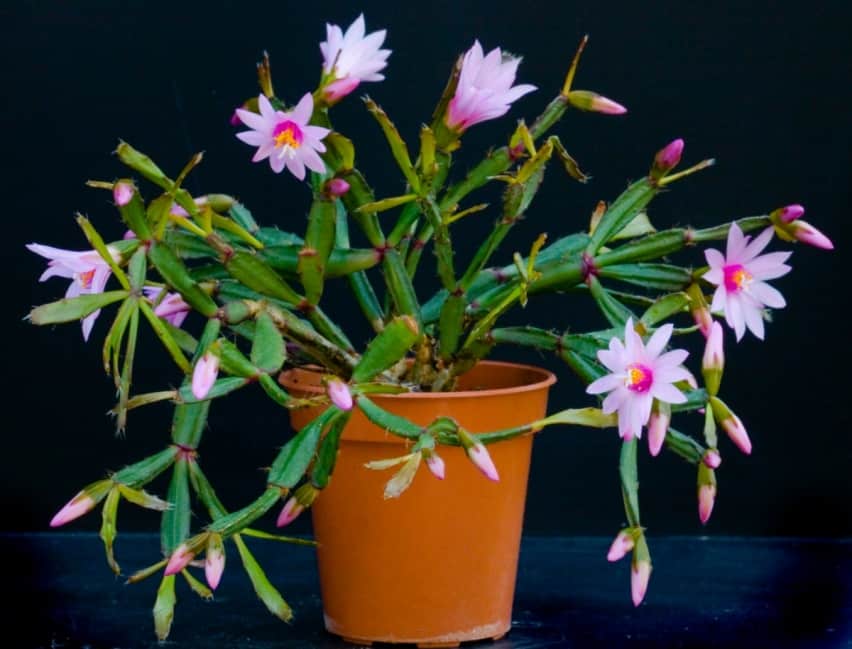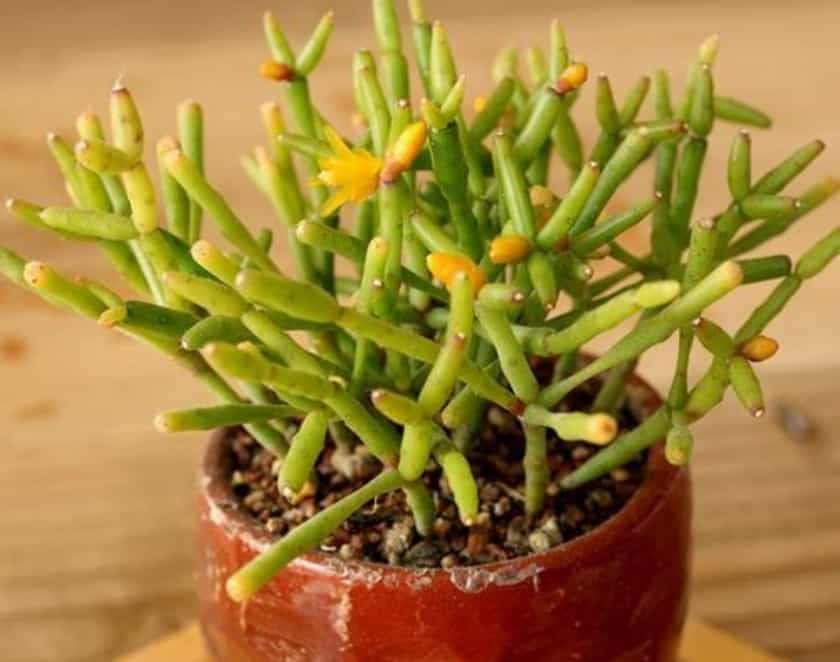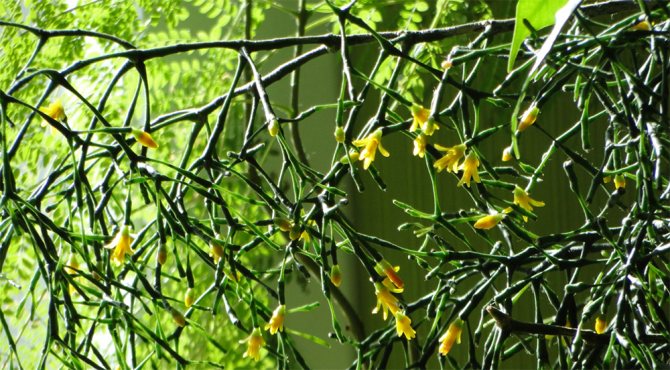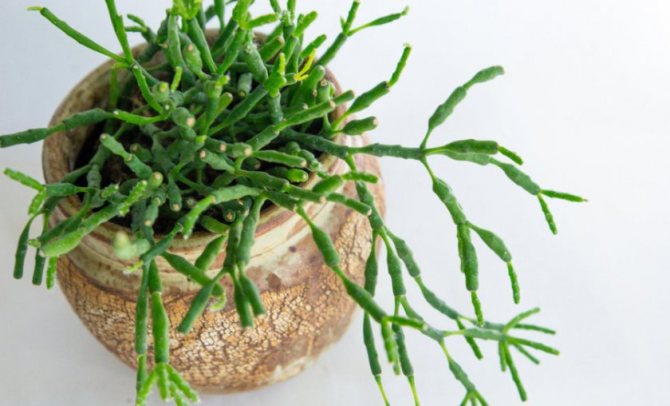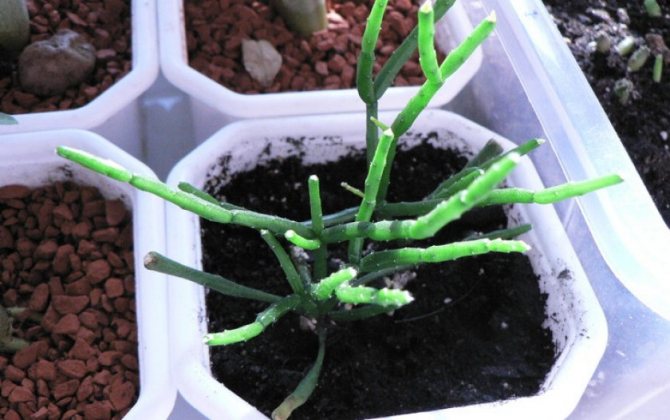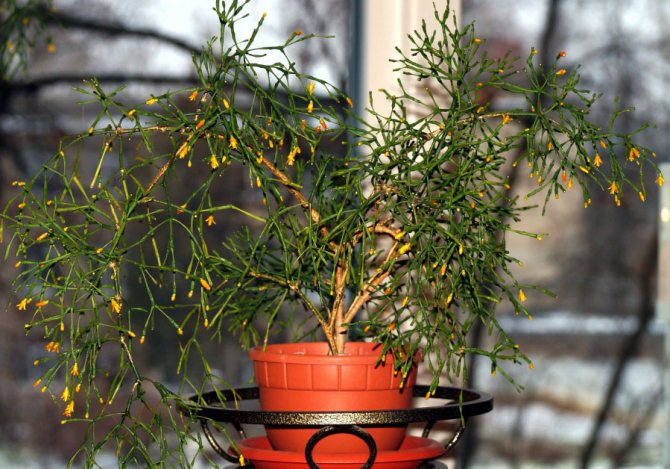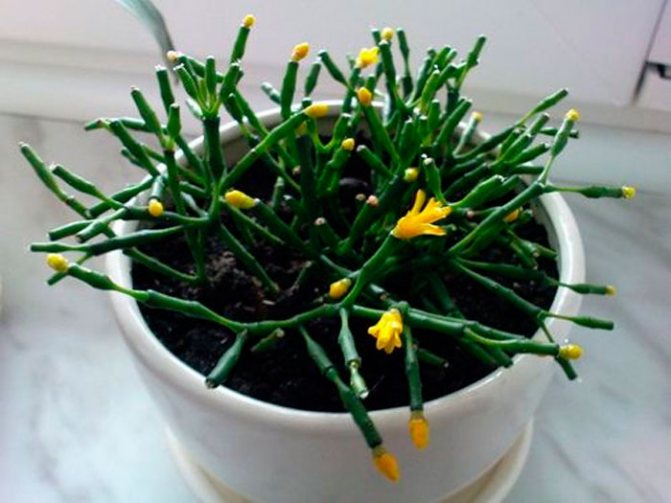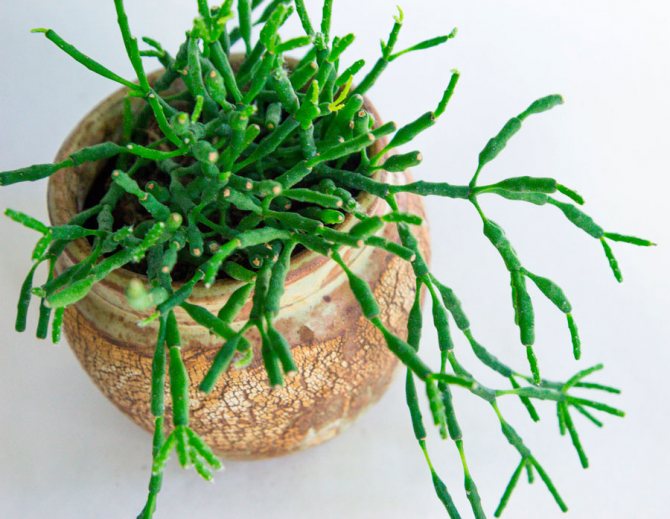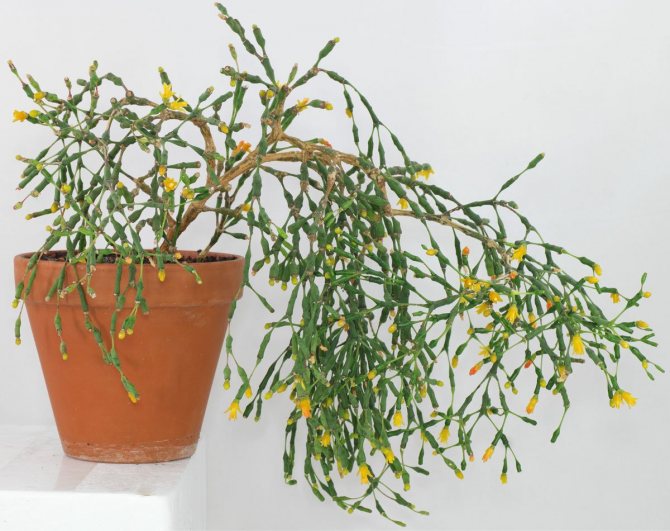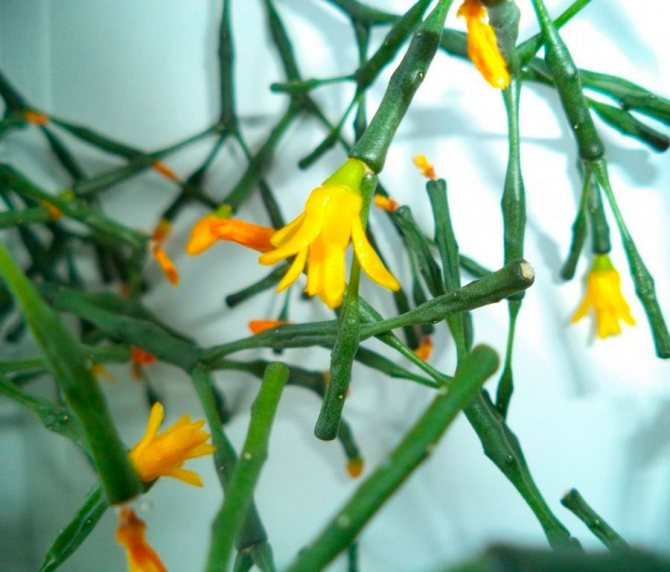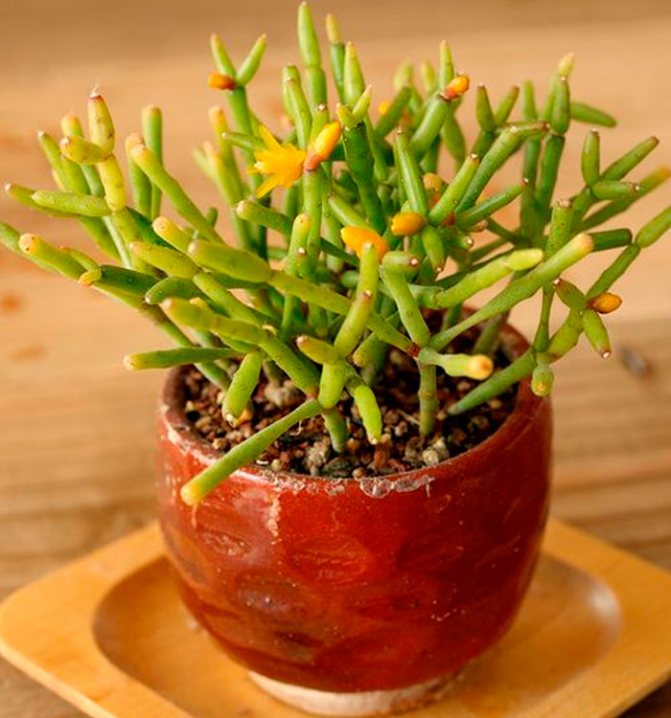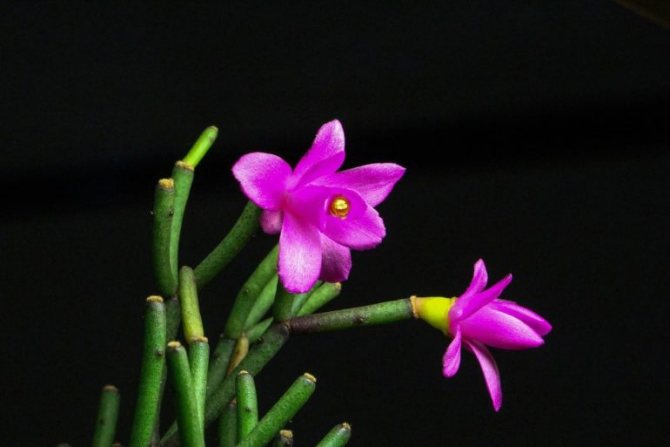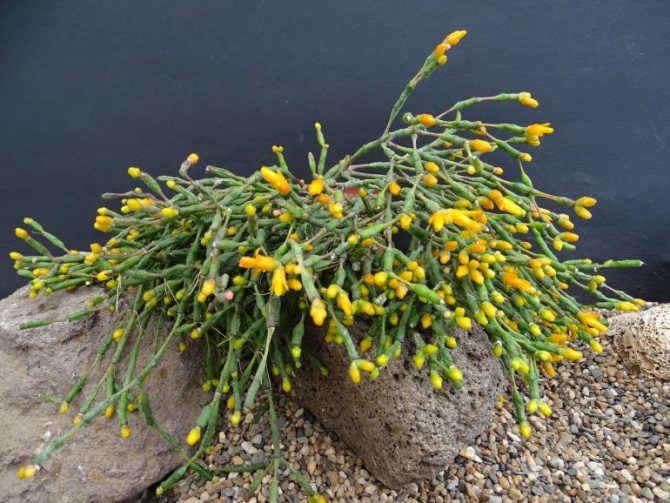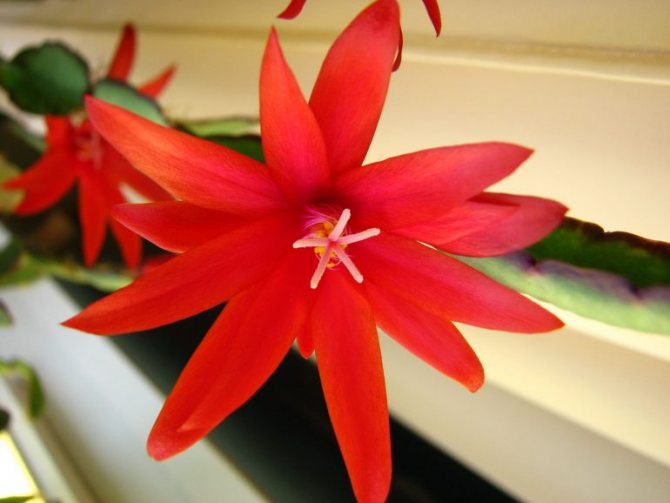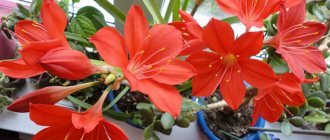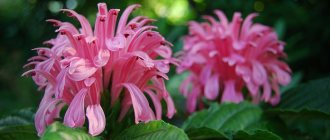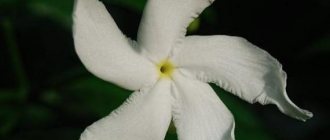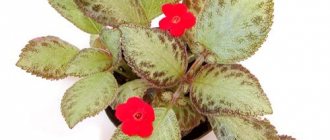Hatiora salicata. Photo Hatiora is an evergreen epiphytic succulent from the cactaceous family. It is characterized by highly branching, lignified shoots, consisting of separate segments. Segments, depending on the type, can be flattened, cylindrical or pin-shaped.
The homeland of Hatiora is the rainforest of Brazil. Under natural conditions, it grows on the trunks and branches of trees; in indoor conditions, a substrate is used for cultivation. Flowers are laid only on the tops of young corollas. Depending on the species, they can be yellow, pink or red.
Also look out for the beautiful Schlumberger plants and prickly pears.
| Low growth rate, the increase in length is about 4-5 cm per year. |
| Blooms from winter to spring. |
| Easy to grow difficult. |
| Perennial. |
Superstitions about hathiora
The hatiora has many nicknames. It is called "men's tears", "drunkard's dream" or "dancing bones". Not everyone likes it, not everyone decides to buy a flower and put it in their home, because there are many superstitions.
One of the superstitions says that the flower does not tolerate men next to it. He kicks them all out of the house. Some couples get divorced because of this.
Its drooping, drooping branches with leaves look like the drooping shoulders of a woman, like the drops of their tears. According to superstition, hatiora is a symbol of a woman's loneliness, her longing. Therefore, many housewives are afraid to leave this exotic miracle in their home, contrary to common sense.
Another superstition suggests that it is very poisonous. There is no scientific confirmation of this information. But, just in case, it's best to keep away from pets.
This is interesting: How to sew a jumpsuit for a dog
Hatiora varieties
The following types of Brazilian cactus exist in nature:
- Hatiora pink... The plant stands out for drooping shoots, consisting of dense segments with scalloped ribs, where the length of each can reach 25 mm. Their skin is gray-green, there are reddish streaks. On rare areoles, there are small whitish hairs. At the stage of flowering, the cactus has a pale pink color of flowers, and after them - yellow-green fruits.
- Hatior Gartner... A distinctive feature of the segments is their elliptical shape, the length of each is within 6-7 cm. The color of the compacted lobes with pronounced notches is dark green. Flowering occurs in the spring, the flowers of the pink hatiora are 4-5 cm in diameter.
- Hermine... Cylindrical segments in length grow up to 5 cm, and the length of the entire lash - up to 30 cm. They have lateral processes. During the flowering phase, the plant produces many bright crimson buds, the diameter of which does not exceed 2.5 cm.
- Saline (saltwort)... The peel of cylindrical shoots attracts attention with a pronounced green color. Erect branches are prone to dense branching. The length of one segment is 25-28 mm, outwardly very similar to a miniature bottle. At the flowering stage, the saliferous hatiora produces yellow bell-shaped buds. This plant is also known as Salikorneidnaya hatiora.
Often novice flower growers doubt whether it is possible to keep such an exotic cactus at home, whether it is poisonous or not.There is no need to worry here, the plant is completely harmless and safe for both humans and animals.
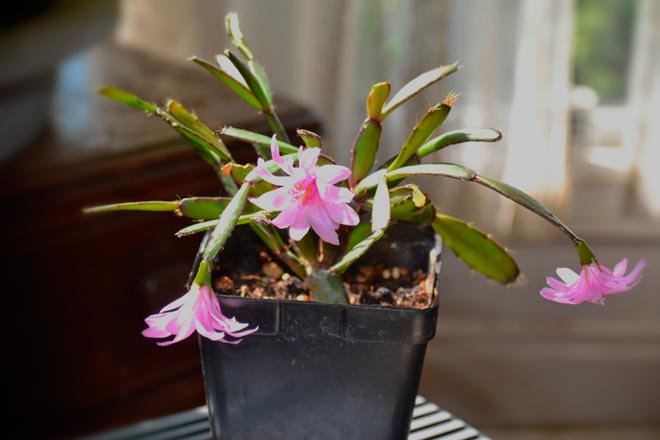
Hermine
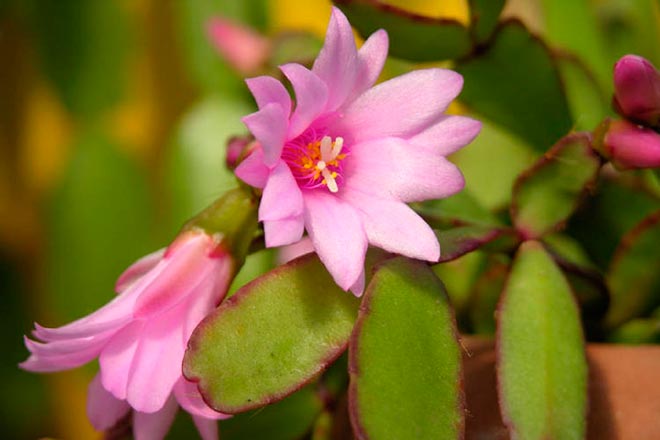

Pink
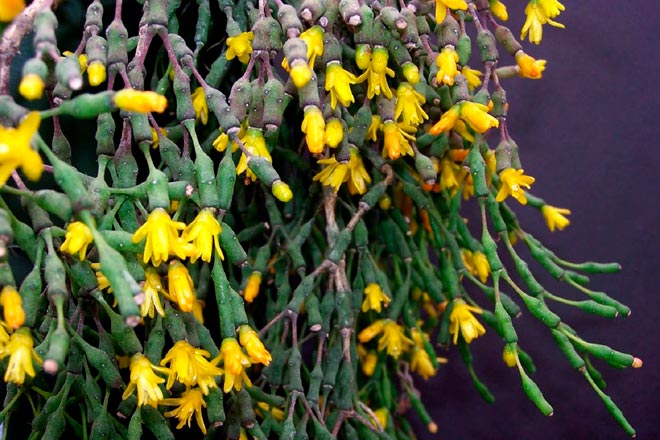

Saline
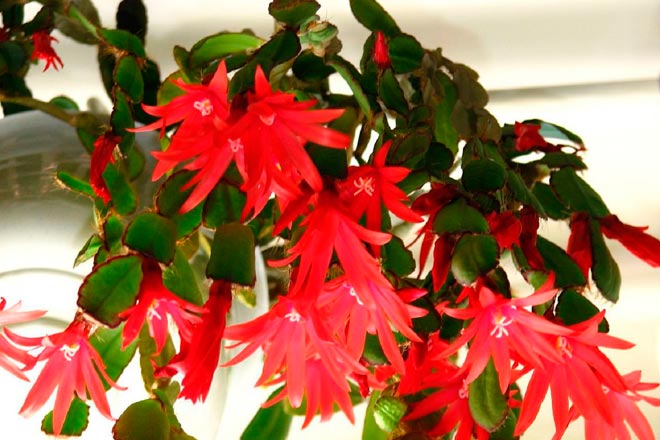

Gartner
Good omens
Good omens of this flower include:
- sudden flowering;
- flowering in a house where the girl is not married;
- sudden flowering in a house where there are no children for a long time;
- a sudden bloom in a poor family.
If a cactus (hatiora belongs to the cactus family) did not bloom for a long time, but suddenly threw away the buds and bloomed violently, this is a big change.
An unmarried girl will find her fiancé and will soon marry. If there have been no children for a long time and have been striving for this, it is time to wait for replenishment. The gender of the child is determined by the shade of the flowers. If they are dark, there will be a son; if they are light, there will be a daughter.
For a married couple, this portends an improvement in their financial situation.
Description and homeland of the cactus
Hatiora or in Latin Hatiora is an epiphytic cactus belonging to the Cactus family. According to various sources, the genus contains from 4 to 7 species of stem succulents. Hatiora is a native of Brazil. In its homeland, it grows as an epiphyte or lithophyte, settling on trees and in crevices of rocks and reaching a height of 1.5-2 meters.
The name of the cactus was given in honor of the cartographer Thomas Hariot
The plant was first described in 1923 by scientists Joseph Rose and Nathaniel Britton, who named it after cartographer Thomas Hariot. It was on his skillfully drawn maps that botanists traveled around Brazil. At first, the plant was called chariota, but later this name was transformed into a consonant with the anagram of the cartographer's surname.
The appearance of the hatiora leaves no one indifferent. It is a bush with a lush crown of highly branching shoots that have absolutely no leaves. The stems of the plant are composed of numerous dark green segments that are club-shaped, cylindrical, or bottle-shaped. Small hairs are barely visible on their surface - these are nothing more than reduced spines. At first, the shoots grow vertically, but with age, they begin to droop slightly.
As it matures, the central stem of the hatiora becomes lignified and it becomes like a small sprawling tree with a height of 50 cm to 1 m, but without foliage. Because of its unusual appearance, the British call the plant "dancing skeleton", "drunkard's dream" and "cactus of dancing bones".
The blooming hatiora is no less impressive sight. During this period, her bush is completely covered with bright flowers of yellow, pink or salmon color. They resemble bells in shape, but with a large number of petals. Flowers bloom from the halo of the apical segments. The flowering period in Russian latitudes falls on the winter season, when the summer is at its height in the homeland of the hatiora.
Bad omens
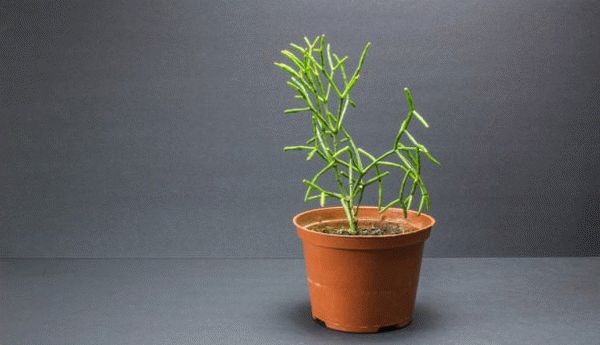

The flower has poor energy
There are some bad omens. Usually cacti are placed in places with heavy, bad energy. No wonder they can often be seen on office desks near computers. The plant feels luxurious where there are often quarrels. It just feeds on this negative energy.
Hatiora takes away the sexual energy, the attraction of spouses to each other, if it is in the bedroom.
There is another popular name for the flower. They call it the drunkard's dream. It has been noticed that often in the house where the hatiora grows, men drink too much. The more a cactus blooms, the more a person drinks.
If you put it in the central room, where the whole family usually gathers, then any holiday can be ruined. The cactus will take all the positive emotions for itself, eat them. It may seem that the quarrel arose from scratch in the midst of everyone's fun.
How to give such flowers
It is better not to give such flowers to your dear people. If you really want to give a flower in a pot, then you need to do this only when the cactus blooms. Then family relations will not worsen.Otherwise, there will be constant quarrels. May get to divorce.
1. Seven Secrets of Success:
| 1. Growing temperature: can be grown at temperatures from 24 to 27 ° C during the growing season, lower the temperature in the winter months to 7-15 ° C. |
| 2. Lighting: Shade from direct sunlight during the daytime in spring and summer. The cactus can bathe in the sun in the morning and evening for 3-4 hours daily. |
| 3. Watering and humidity: between waterings, dry the soil 3 to 5 centimeters deep in spring and summer, and in autumn and winter, keep the frequency of watering to a minimum. Tolerates dry atmosphere well. |
| 4. Features of the: Hatiora is extremely attractive and does not require much maintenance. |
| 5. Priming: nutritious with good drainage. |
| 6. Top dressing: in the warm season, every 2 weeks with mineral fertilizers for cacti. Feeding is often stopped during the winter months. |
| 7. Reproduction: by rooting stem cuttings in the warm season, seeds sown in spring. |
Botanical name: Hatiora.
Hatiora flower - family... Cactus.
Origin... Brazil.
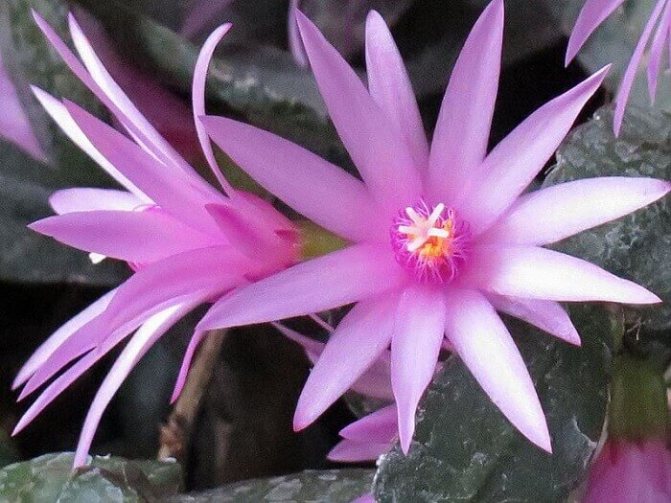

Description... A small genus consisting of 5 - 6 plant species. Hatiora is a low epiphytic cactus, which is a shrub with light green segmented stems. The segments are oblong, cylindrical or flat, chaotically directed, abundantly branching. In spring or summer, abundant bright flowers appear on the tops of the shoots - yellow, pink, lilac or red. The diameter of the flowers can be up to 7 cm.
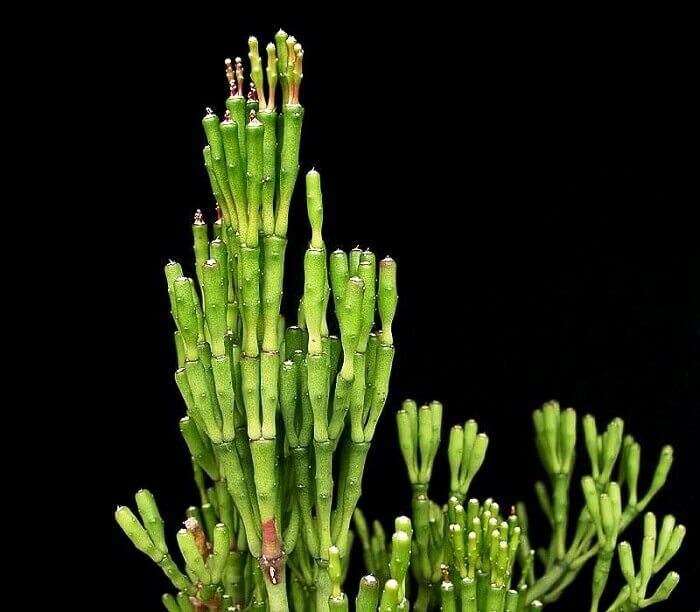

Height... Often does not exceed 40 cm.
How to choose a place for a hatiora
In order for the hatiora to protect the house and bring only good, you need to choose the right place for its growth. Auspicious places include:
- kitchen
- windowsill
- Desktop
- next to the computer
- in the hall
The kitchen will take over all family quarrels. The windowsill is well lit, and the cactus is very fond of sunlight and warmth. With pleasure, the cactus begins to radiate positive energy from itself.
A computer in the network emits a mass of various energies, positive and negative information. It settles in an invisible veil all over the room and on the person sitting next to it. If you put a cactus next to the screen, then it will absorb all the negative. It will absorb it and will not allow it to affect the owner.
On the desktop, it will help get rid of irritability and fatigue accumulated over a working day. Grievances will go away, leaving behind only a faint shadow of memories. There is no better place for dancing bones.
Hatiora, standing in the corridor or in the hallway, most importantly in front of the front door, will make the house inaccessible to evil people. A bad person with bad thoughts or intentions will not get into the house. Spoilage and evil eye will be driven away by small thorns of this beautiful flower. All negativity directed at the owners of the house will be deactivated.
Where to put the flower
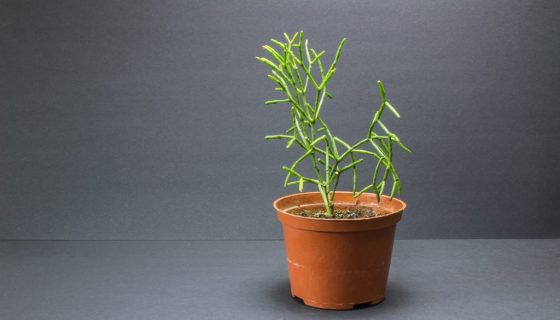

We put the pot in the right place
Since a cactus protects a person from otherworldly forces, evil, evil spirits and bad people, you need to choose the right place for him in the house.
Auspicious places
- Kitchen - there the cactus will absorb energy from quarrels and family disagreements, take all the negativity onto itself.
- Windowsill - a lot of light and heat will help the cactus emit only good energy.
- Desktop - there can be nothing better than a cactus in the workplace, because it absorbs all difficulties, fatigue, irritation and grief.
- Near a computer is the most popular place for a cactus, as it absorbs negative rays from a computer and a modem, preventing them from reaching a person.
- Entrance hall - if there is a lot of light in the corridor, then this is an ideal place for Hatiora, it helps to avoid bad people and will not let something bad into the house.
Unfavorable places
If you place a cactus in the wrong room, then discord will settle in the family. Bad places are:
- The bedroom - the place where a person sleeps, is unsuitable for Hatiora, because she can disrupt sleep, cause headaches and loss of appetite.
- Children's - a child can prick, because the thorns are very sharp and the cactus can cause aggression and sudden cruelty in children.
- Living room or hall - the place where the family spends most of the time and rests, unsuitable for thorny plants, peace can be disturbed and the house will always be noisy.
It is possible to determine whether the hatiore is good in the house, if the owner of the plant is not well around him - the cactus does not like the person. But if the owner feels great, the cactus likes the person and the house in which it grows.
Hatiora care
In order for a cactus to bring joy and emit only positive energy, it must be properly looked after.
It is important that he obtains living conditions close to his natural conditions. His homeland is Brazil, a warm and sunny country. Therefore, the lighting must be good and constant. But direct sunlight can burn the leaves and trunk. Better to put on the west or east side of the apartment.
It does not tolerate cold and dry air. Therefore, it is better to water as the soil dries up in the pot.
In the very heat, spraying with soft and settled water is recommended. Be sure to feed. One negative energy in the house, a flower for growth and development, is not enough. Feeding is done 2 times a month with a special fertilizer for succulents.
After flowering, it is better to transplant it into new soil. If the plant has grown, the pot needs to be resized. For propagation, cuttings are taken and rooted in sod or sandy soil.
Reproduction
In its natural habitat on trees, Hatiora grows due to the formation of roots in the sinuses between the segments. IN potting conditions for reproduction, it is enough to place a stalk from 2-3 segments in loose soil or water before rooting. Usually this process takes no more than a month, after which the plant begins to actively grow.
Sometimes the segments that have fallen off can take root in a pot next to the mother cactus.
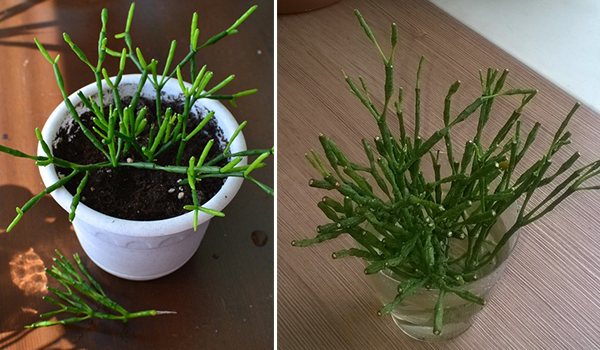

Cactus Hatiora: ways of care and growing a flower
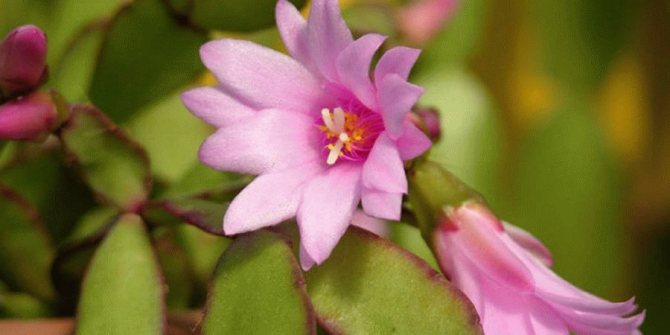

Hatiora - a fairly well-known and popular genus of decorative cacti. The name of this genus was given in 1923, in honor of the mathematician Thomas Hariot. And today, 5 or 6 plant species are referred to the Hatiora genus. Many species have arched stems and are placed in hanging baskets or pots.
Hatiora's stems are either flat, leaf-shaped, or circular in cross-section. Depending on the variety, the stems are very long - from 50 centimeters to 2 meters. The stems are green all year round. They are smooth, without spines and hairs. Their small, funnel-shaped flowers grow at the ends of the stems and look like daisies. The color of the buds ranges from yellow-orange and pink to bright red.
It's interesting: How Maxim Fadeev lost weight
The most popular species among gardeners are hybrids. - Hatiora Gaertneri and Hatiora Rosea. They can be found in garden shops all over the world. Also, these hatiors have an alternative name "Spring cactus" or "Easter cactus". All due to the fact that most often they bloom in the spring. Although, with proper care, they bloom 2 times a year or even more often.
Another common species is Hatiora Salicornioides. They are slender, erect plants up to 60 cm in height. The stem consists of small segments (up to 3 cm in length). The flowers are small, bell-shaped, orange-yellow in color.
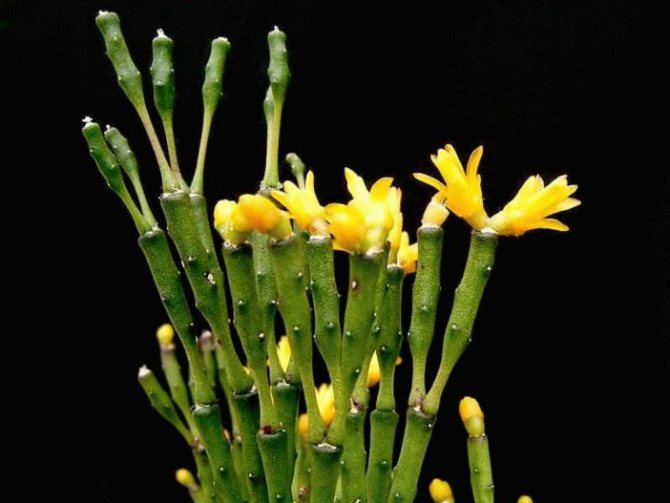

Wild Hatiors bloom in spring. They grow in the tropical rainforests of Southeastern Brazil, as well as in the south of the state of Parana, on the border with Paraguay.And although they are epiphytes: they grow mainly on the trunks of other trees, sometimes flowers are found growing on rocky soil.
Growing hatiors from seeds
Seed propagation in indoor floriculture is rarely used. Sowing seeds is most often used for breeding purposes. This is explained by a rather long growing period. It will take 3-4 years for the seedlings to turn into full-fledged, well-developed plants.
If necessary, seeds are sown superficially into a loose, moisture-consuming substrate. To create increased humidity, the container is covered with a piece of glass. After emergence, it is immediately removed.
As soon as the seedlings reach a height of 2-3 cm, they are carefully dived into separate containers. Caring for them is similar to caring for adult plants.
Growing conditions
Shine: these tropical cacti don't like bright lights. Never leave them in direct sunlight or midday sun.
Water: unlike other cacti, the soil of these plants must be constantly moist. But care must be taken that the ground is not too damp.
Recommended reading: How often to water cacti?
The soil: in the wild, they grow on rocks and trees, so these flowers require dense soil. They grow well in a mixture of earth and pumice (preferred) or tree bark. The usual ratio is 1 to 1.
Fertilizers: during the active period of growth, Hatior needs to be fertilized 1-2 times a month. During the rest period, it is worth stopping feeding.
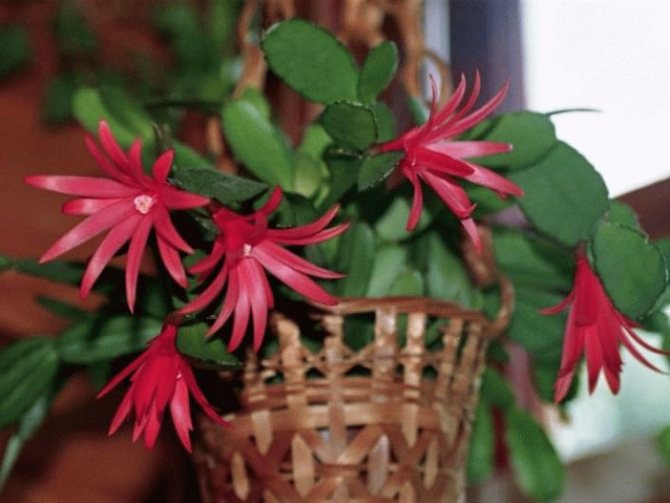

Reproduction of the hathiora cactus
Hatiora is easily propagated by stem cuttings. To do this, cuttings with 2 or 3 segments are unscrewed from the mother plant (do not cut off!), Sprinkle the place of fracture with crushed coal and dry the branches a little in air. Next, the cuttings are buried in a wet substrate of sand and peat. After about a month, when the cuttings are rooted, you can transplant them into permanent pots.
If, if necessary, there is no suitable substrate to propagate the plant at hand, you can root the cuttings in water, and then, after the roots appear, plant them in the ground. And sometimes the segments that have fallen off the adult bush, falling to the ground, root themselves, forming young shoots around the plant.
Hatiora can also be propagated by seeds., but this is a longer and more laborious process. The collected plant seeds are immediately sown into a moist peat-sand mixture and placed in a warm place with a temperature of at least 20 ° C. After a while, with regular moisture, the first shoots of the hatior appear.
Plant care tips
- comfortable conditions for the hatiory - indirect light, as well as morning and evening sun;
- the soil must be well drained;
- this flower loves long nights - 12-14 hours. Therefore, we advise you to keep the plant under a paper bag to protect it from excess sunlight;
- it is not recommended to touch the plant during the flowering period, as the buds can fall with any movement;
- within a month after the hatiora has faded - reduce the frequency of watering.
Reproduction of hatiora by shoots
Hatiora is most often propagated by cuttings. Cuttings can be harvested throughout the year. For their planting, a loose soil is prepared, composed of equal parts of humus and clean river sand. Before planting, cuttings must be dried for 3-5 days. When planting, they are buried no more than 1-1.5 cm.
It is not recommended to cover them with foil. In conditions of high humidity, cuttings rot very quickly. When creating favorable conditions for rooting, it will take about a month. After the development of the root system, the cuttings start growing very quickly.
Rooting of cuttings can also be carried out in water. For this, they are also pre-dried. The need for drying can be explained very simply. Like all succulents, the shoots have a fairly large supply of moisture and nutrients.Until the plant has used up all the resources, it does not need to develop the root system. But with a lack of nutrition, in order to survive, the cuttings will have to release roots.
When rooting in water, a small piece of charcoal is placed in the container to prevent decay. After the development of the first roots, the cuttings are immediately planted in a soil mixture for adult plants. Their prolonged presence in water is undesirable. Getting used to the aquatic environment, they are much more difficult to adapt to normal growing conditions.
Signs and superstitions
One of the types of Hatiora, which we wrote about above, is called the Dancing Bones. The British did it, but in our country these flowers have a different name - men's tears. There is an opinion among the people that ampelous plants become the cause of family discord and loneliness. This is where the superstitions associated with the Hatiors end.
Believe it or not - everyone decides for himself - that's what superstitions are for. In our opinion, there is only one thing to be wary of - some species of these plants are poisonous and can harm your pets. We are sure of one thing: these flowers look great and give a real aesthetic pleasure.
Types and varieties of hatiory for growing at home
Five reasons to grow an exotic plant at home:
- Easy care.
- Spectacular view, several varieties for growing in an apartment.
- There is no need to create an unusual microclimate for household members.
- Flowers in several shades.
- You can surprise guests and relatives with an original, green decor.
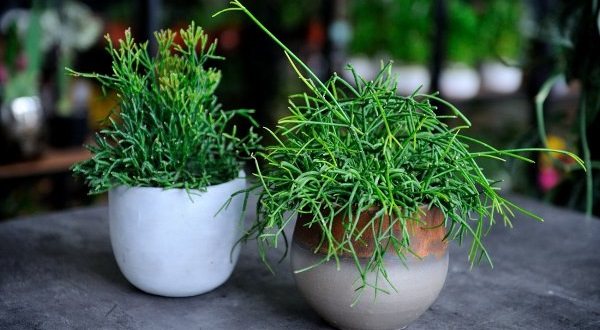

Popular Hatiora varieties:
- Gartner. Long shoots, beautiful bell flowers, rich crimson petals.
- Saline. The species is often bred at home. Solyankovy hatiora has keglevid segments and long (up to 40 cm) shoots. Bell buds give yellow, red and pink colors.
- Grezer. A hybrid of two types of hatiora: pink and Gartner. Interesting shades of petals: dark red, there are plants with a different color of bells on long shoots.
- Pink. The segments resemble a mace or ellipse, the shoots are flat, the color is green with a red tint, the flowers are large - up to 4 cm in diameter.
- Five-winged. Many white buds, small flowers, pentahedral shoot segments.
- Gartner. Each shoot has several large segments, the flowers are large, funnel-like, the color is deep red.
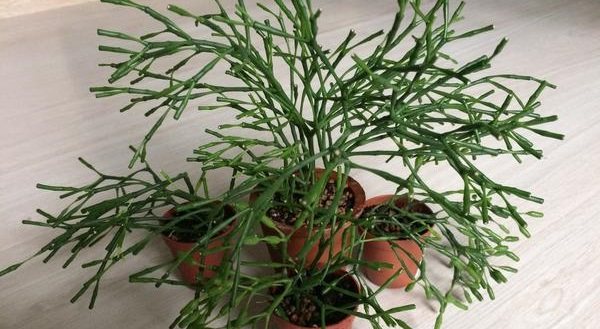

Initially, an epiphyte with an original structure of leaves and bright yellow flowers was intended to be named after Thomas Harriot, a famous British mathematician and fan of long-distance travel. However, the species "Khariota" was already in the botanical classification. After some deliberation, experts decided to give the new species from the Cactus family the name "hatiora", after changing the order of several letters in the word.
Superstitions about Hatior
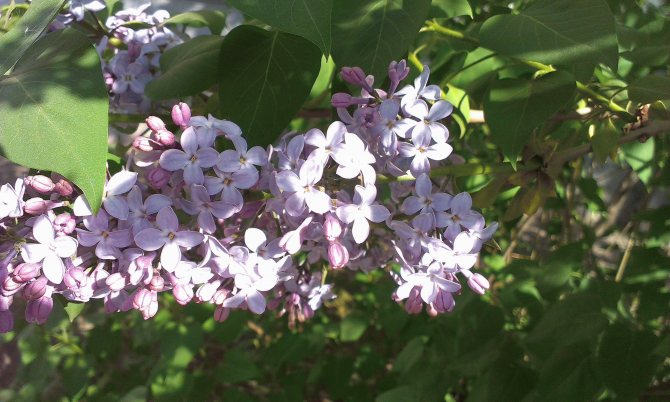

Hatiora is a wild plant of South America that is completely devoid of leaves, but like many succulents or cacti, the stem of the flower is fleshy and has many small processes. Despite the fact that in the wild, Hatiora grows in crevices of rocks and on rocky soil, this flower has become a favorite among other unusual plants among lovers of indoor greenery. Small, indoor flowers of Hatiora, in the wild, can grow up to several meters in diameter and create a whole carpet of unusual inflorescences.
It is also interesting that for its unusual shape, the plant was named the dancing skeleton and very quickly overgrown with all sorts of superstitions, omens and legends.
Blossoming of Hatiora
All Hatiora species begin to gain color in early spring. The blossoming flower retains its beautiful appearance for only a few days, but uneven formation buds on different shoots prolongs the overall flowering period up to 2 months.
The difference between flowering and similar cacti is that they form on the end segments, and Hatiora Rhipsalis blooms in the intersegmental sinuses. along the entire length of the shoot.
After the flowers wither, berries are formed in their place, in which the seeds ripen.
Hatiora signs and superstitions
The most common superstition associated with this plant says that this flower is absolutely intolerant of the male sex. Many esotericists argue that the appearance of Hatiora, with its lowered segmental branches, symbolizes female shoulders, drooping under the burden of melancholy and disappointment. Others say with confidence that this is a symbol of women's tears, from unrequited love. One way or another, superstitious women will never put this plant at home, especially if they do not want to lose their beloved man.
The second point that does not recommend keeping this plant in the house is its unjustified fame as a poisonous flower. Scientifically, no one has been able to prove that the flower of Hatiora is capable of poisoning someone with its juice, even when eaten. Despite this sign, many pet lovers hesitate to grow this plant in the house.
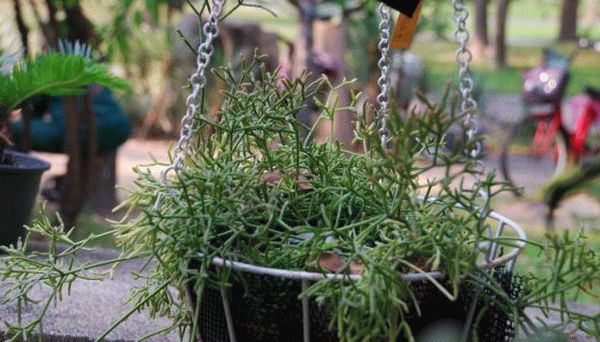

Hatiora transplant
Given the fact that as the hatiora grows, it grows strongly, then it needs to be provided with enough space for growth. Therefore, periodically replanting this plant is simply necessary.
This should be done very carefully, due to the fragility of the stems. Moreover, in some cases it is necessary to provide additional support for proper growth.
While the flower is still young, it needs a transplant every year, but an adult one after 3-4 years. In addition, the transplant helps to rejuvenate the flower.
Hatiora houses folk omens and superstitions
The peoples of South America, however, like most lovers of these exotic flowers, associate Hatiora with a number of predictions, both with a positive and a negative outcome. Positive signs include the following:
- If Hatiora unexpectedly blooms in a house where a couple lives without children, then most likely they will be replenished. Moreover, if the flowers are dark, then a boy should be expected, and if a light shade, then most likely a girl will be born.
- For an unmarried girl, a blossoming flower prophesies to find her betrothed in the near future.
- Another superstition associated with the sudden flowering of Hatiora is an increase in finances and wealth, especially for low-income families.
It is important to understand that, in general, the flowering of this plant is a good sign promising good luck, prosperity and positive changes in life.
Many are afraid and wonder whether it is possible to keep Hatiora at home because of negative signs. In fact, there are not so many superstitions of these:
- The drunkard's dream flower. Long-term observations have shown that in a house where there is this plant, very often people suffer from alcohol addiction. And it is mainly men who suffer.
- Good growth of this succulent is observed in places and rooms where negative energy is constantly present. Although this applies to all types of succulents and cacti, Hatiora is especially distinguished in this regard. That is why this plant can often be seen blooming in office spaces, conference rooms and kitchens in disadvantaged families.
- Another superstition is that Hatiora takes away sexual energy from both men and women. It is for this reason that it is not recommended to put this plant in the bedroom, as spouses may completely lose their desire and attraction to each other.
- It is undesirable to put this plant in the room where family gatherings take place, holidays are celebrated, and the family dines. You won't have to wait for positive emotions, they will all be absorbed by this cactus.
It's interesting: How to determine the gender of a chinchilla
Diseases and pests
Like any plant, if not cared for properly, Hatiora is easily susceptible to disease.
Bacterial infections
A sign of bacterial infection is wet, small foci with signs of rotting on the shoots. Such places are covered with a mucus-like coating.
Antimicrobial treatment ineffective, so you should immediately remove damaged segments and take care of the plant.
If the disease is neglected and the main trunk is damaged, then you need to select a healthy cutting and root it for the growth of a new plant.
Fungal infection
Fusarium blight manifests itself as black streaks and rings on the cuts and discolored spots on the surface of the shoots. A whitish color may appear on the stem. or mold with a red tint.
The fight is carried out with a solution of Fitosporin or Trichophyte, removing the damaged part or completely replacing the plant from a healthy cutting.


Late blight is manifested by brown spots and the gradual wilting of Hatiora. At the first sign, you can try to treat it with a fungicidal means and be sure to isolate the pot from others plants. Proper maintenance is required with reduced watering and frequent ventilation.
If the disease continues to spread, it is best not to endanger other flowers and grow a new plant.
Important! The soil in which the affected Hatiora was located should be destroyed. Use new disinfected soil with suitable parameters for rooting the cuttings.
Reviews of the signs of the flower of Hatiora
Not a single superstition associated with this plant has scientific confirmation and, accordingly, believing in them or not is a private matter for everyone, but judging by the reviews of many fans of unusual plants who start this cactus at home, signs really find confirmation. Although, this may be a banal coincidence or the desire of the person himself to connect causes and effects. In any case, the inhabitants of South America do not seek to grow a flower in the houses where they live.
On the other hand, the claim that cacti and succulents are able to protect humans from electromagnetic radiation is not such a myth. Indeed, computers and other office equipment emit a wide spectrum of waves that have a depressing effect on humans. Hatiora is able to perfectly absorb this negative energy, thereby protecting a person. Another superstition associated with the hatiora, which has been tested and about which you can find true reviews on the Internet, is related to the content of the flower in the corridor. By placing the plant in front of the front door, you can not be afraid that ill-wishers or people who carry a charge of negative energy will enter the house. Also, being in the hallway, Hatiora is able to ward off damage and the induced evil eye.
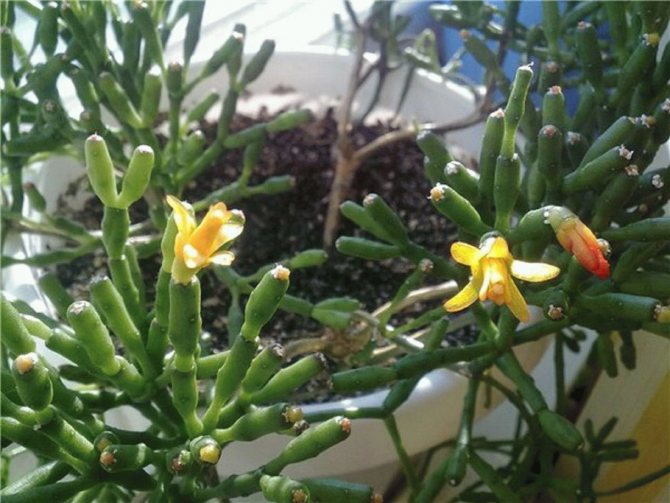

Alternative view
The unusual appearance of the hatiora cactus has become a topic of discussion in different countries. For many, its shape resembles bones, although some believe that the shoots look like corals or small bottles. Despite the fact that the plant is classified as tropical and it grows in the forests of Uruguay, Brazil, it is easy to grow it in countries with cooler climates.
Hatiora is an unusual succulent
Interesting names given to him by the people: "drunkard's dream", "men's tears" and even "dancing bones".
Hatiora is an evergreen plant that blooms from December to March. Delicate yellow flowers cover the shoots profusely and create a very unusual and elegant look. After the flowers have faded, berries will form in their place, and the plant will take on an even more unusual appearance.
The structure of the succulent has the appearance of green segments without leaves and thorns. The root system is fibrous. The plant receives moisture and nutrients from the air. It grows slowly, so often its height in the first five-year period barely reaches 35 cm. It becomes high only after decades.
Views
Promotional video:
There are several types of hatiora:
- pink hatiora (Hatiora rosea);
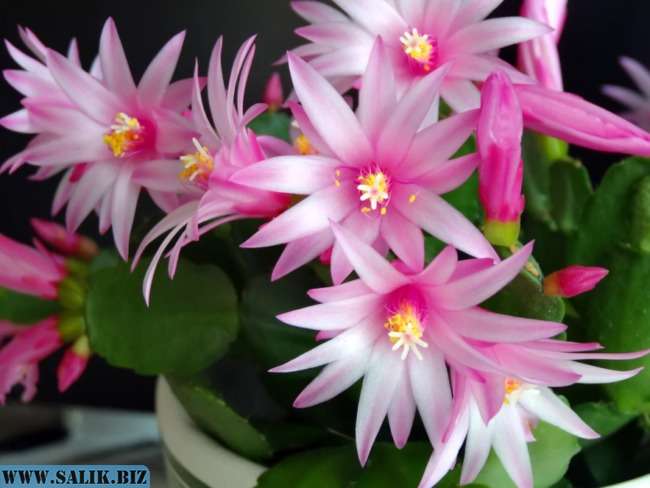

—
- Hatior Grezer;
- hatior Gartner (Hatiora gaerneri);
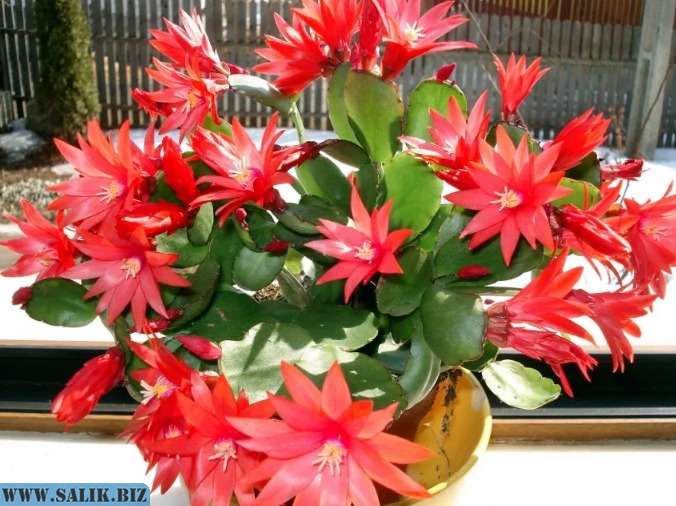

- Hatiora herminiae;
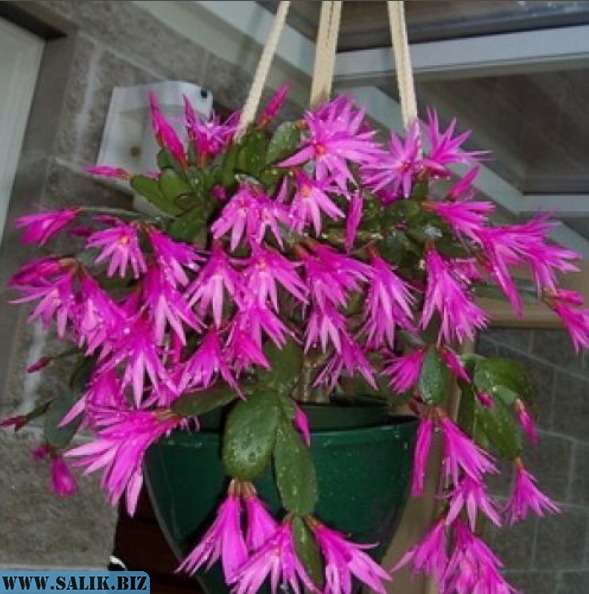

- hatiora salicornioide (Hatiora salicornioide) - the most common;
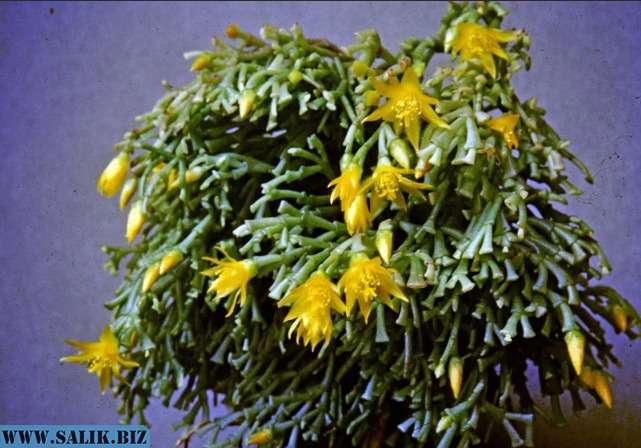

- hatiora salicata, etc.
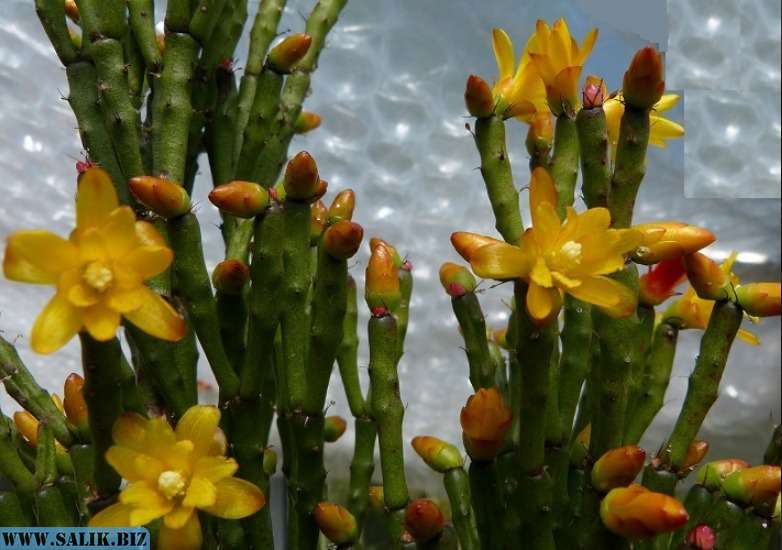

Segments in different varieties have a cylindrical, flat or clavate shape. Segments are covered with flowers in winter; this rare property is especially appreciated by flower growers.
In modern sources, the genus Ripsalidopsis ("Decembrist") does not exist and it is considered a subspecies of the genus hatiora.
Hatiora: good folk omens
Succulent plants are endowed with various superstitions for their mystical appearance. Of the favorable signs, it is worth noting their flowering. The yellow and coral flowers that cover the stems are definitely eye-catching. In the event that the plant did not please with the appearance of flowers for a long time, and suddenly bloomed, then according to signs it is believed that changes will have to be expected soon. Moreover, the plant carries only positive changes in this case. So hatiors are always looking forward to blooming with great joy.
The omen about the place where the plant bloomed is interpreted in an interesting way. If flowers appeared in the house of a woman who is married, then this is a sign of an imminent replenishment in the family. Dark flowers - expect a boy, and light - girls.


If the plant showed flowers in the house of an unmarried girl, then you should expect an imminent wedding.
If flowers appeared in a family with children, this symbolizes an increase in salary, unexpectedly good earnings, or an improvement in the financial condition of the family as a whole.
The positive impact of the hatiora is also associated with the place where it is placed in the apartment. If you are afraid of a bad influence on your home, bad energy from coming people, guests, then it is recommended to put this flower next to the front door. In the hallway, this flower, thanks to its needles, will help drive away bad thoughts from the owners of the house, and will not allow damage and the evil eye to penetrate into the apartment.
Bad omens and superstitions
But bad omens are also associated with this plant.
If we consider cacti, then we can safely say that they do not grow in every home. It would seem an unpretentious plant, but it requires proper attention and special location.
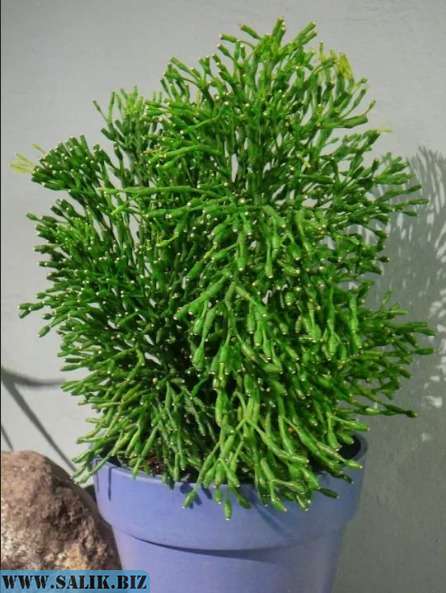

Reference! By the way, the hatiora does not grow in any home. The plant takes root only in places with poor energy. A house where couples constantly quarrel, where there is no place for calmness and good mood, becomes a favorite place for this flower. It is believed that the more troubled relationships in the family, the better this flower grows.
There is a belief that the plant negatively affects the relationship in a couple, and can affect not only the communication between husband and wife, but also reduce their sexual energy, can lead to negative consequences.
Believe it or not in such a hopeless prospect of finding a flower in an apartment, it is certainly everyone's business. But it is still recommended to listen to the signs. So, if the plant grows in the house, then it is worth taking a closer look at what is happening in the family. In this case, it is imperative that someone in the family drinks heavily or others.
It is also worth taking a close look at the plant itself. If you want the person to receive less negative energy, then it is worth keeping this flower away from the places where it is most located in the apartment.
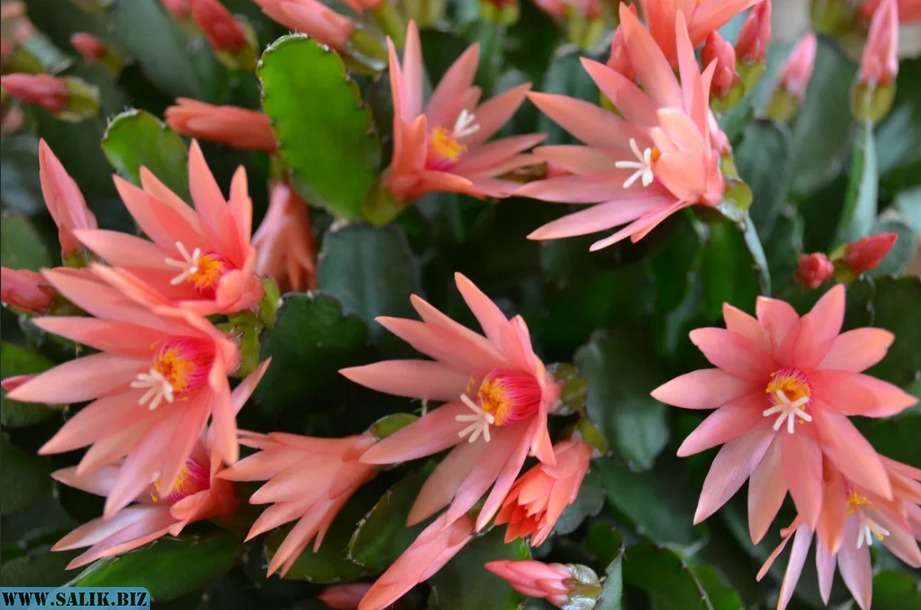

Where to place the succulent plant?
The plant loves light rooms, so it is worth choosing a room for it with diffused light. Direct sun exposure should be avoided. A succulent plant does not like drought either, so it is worth choosing wet places and constantly spraying the hathiora if you want it to grow well.
Advice! The ideal side of the world for placing a plant on a windowsill is the west or east side.
How to grow a healthy plant to bring joy and protection to the family?
First of all, it is worth with a little skepticism about all the signs associated with the plant.If the relationship in the family initially did not differ in special warmth, then it is unlikely that the flower can significantly worsen them. But it is still worth taking a closer look at the place where you plan to place the succulent plant. The ideal place is the kitchen. The flower will be able to take away all the bad energy from the house.
You can also put such a plant in the workplace, because it is there that it will be able to absorb bad energy, stress, misunderstanding and irritation.
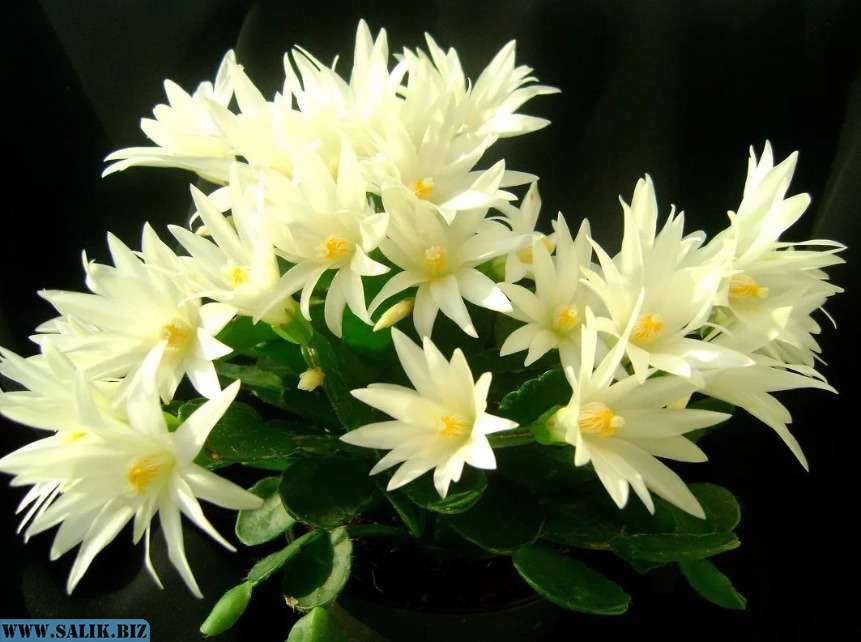

It is very good to put the plant near the computer. It will not allow the harmful effects of technology to pass on to humans.
Choosing a hathiora for its beautiful appearance, it is still worth taking a closer look at the recommendations on where it is better to put the plant. It often happens that the flower shows its positive properties depending on the location. You should also believe in omens, because folk wisdom is very often tested for centuries, and speaks the truth. But still, when choosing a plant for a house, the main thing is that you really like it.
Zhanna Lyubarskaya
Bloom
The abundance of flowers on a bush depends on how the plant has spent the rest period. If this period was maintained correctly, then the plant has time to accumulate nutrients and form flower buds in large quantities. But if you notice that the plant began to wilt during this period, then you can water it a little.
After one or two months of rest, Hatior needs to be brought into a warm room and started to water. It is necessary to spray if the air is too dry. Soon after, the bush is covered with many buds. From their appearance, you can start feeding with fertilizer with an increased amount of potassium, for a brighter color of flowers.
If your plant has not bloomed, there may be several reasons:
- Failure to comply with the regime of wakefulness and rest;
- If the plant is still small;
- Lack of moisture and light.
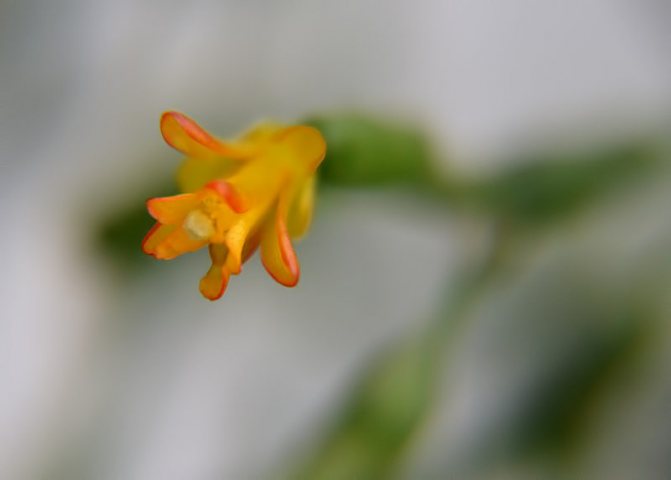

Hatiora vaccination
Sometimes, for abundant flowering, experienced florists vaccinate hatiors... For this, another plant is taken - pereskia prickly.


The sequence of actions for the formation of the vaccination is as follows:
- The pereskia (stock) is trimmed to the trunk, the top of which is slightly bifurcated.
- A shoot with 3-4 segments is pinched off from the hatiory (scion).
- The cut of the scion must be formed in the form of a wedge, for which a triangle is cut out with a sharp knife with the top inward.
- Hatiora is combined with the pereskii trunk and carefully wrapped with electrical tape or plaster.
Average the vaccination takes 2-3 weeks, which is manifested by the beginning of the growth of new shoots. From this time, you can remove the bandage from the trunk.
Thanks to the more developed root system of the pereskii, branch formation will be rapid and flowering will be lush.
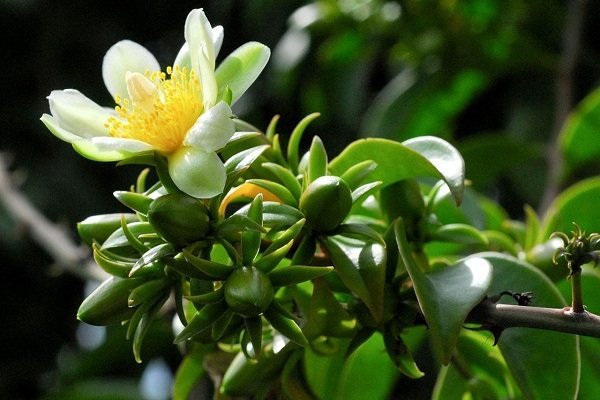

Reproduction and care
Hatiora is a perennial flower. And blooms long enough. This happens, however, not immediately. New plants obtained through reproduction begin to grow and bloom after a few years. A hatiora plant, reproduction and maintenance of which must be continuous, can be propagated in two main ways: by seeds or by cuttings.
Each method is considered effective and quite convenient. In addition, you can collect several cuttings or plant many seeds in one vessel or pot, this will allow you to recreate the thickets of hatiora, as in the Brazilian tropics.
Purchase and adaptation
In the spring, there are blooming cacti on sale, but after buying them, all the beauty crumbles. The fact is that they were grown in greenhouses using growth stimulants. Artificial flowering takes all the strength from the plant, therefore, during transportation and during adaptation, it can get sick and die.
It is better to purchase non-flowering specimens or grow them yourself from part of the mother shoot (propagate by cuttings).
The price of a hatiora depends on the size and variety. On average, it costs 200-1700 rubles.
What to look for when buying:
- The stems are strong.
- The soil is dry - if it is wet, it means that the cactus has been on the shelf for a long time and moving to a new house will cause him severe stress.
- There are no stains or damage.
The indoor flower is kept in quarantine for two weeks to prevent possible infection of other green pets.
Tropical inhabitants require gradual adaptation to new conditions. Immediately after purchase, they must be transplanted into new soil, clearing the roots from the old (pruning of damaged roots may be required).
A cactus should be placed on a sunny windowsill after the adaptation period.
Landing
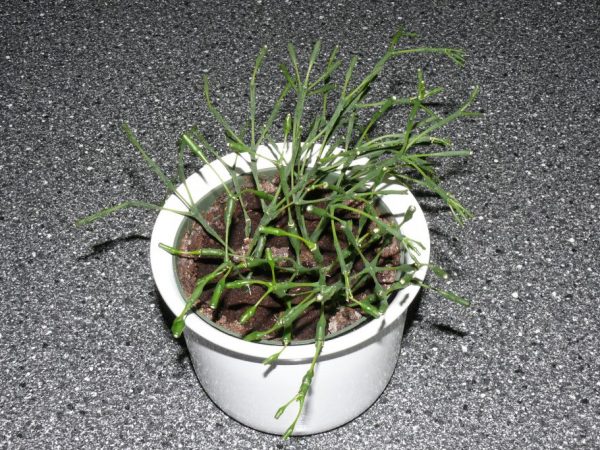

Do not expose the plant to the rays of the sun
For planting, it is enough to root the cutting in moist soil.
Please note that an adult plant should not hang out in the pot. Too large a capacity can provoke insufficient drying out of the earth and rotting of the root system. For proper shoot growth, you can put small supports.
Hatiora can be grown by the ampel method.
About pests of hatiors
Not all pests prefer succulent plants, however, mealybugs, scale insects, spider mites or whiteflies can grow on cacti. Infection of a flower with a worm can be recognized by white spots on the stems, a spider mite - yellow dots on the shoots, by other parasites - by the yellowness of the shoots and the general soreness of the hatiora.
Having found insects on a plant, first of all, you should isolate it from other indoor flowers, having previously examined them. With a slight infection of the cactus, you can remove the parasites manually or put the bush under a stream of warm water (no higher than +40 degrees). And then irrigate the stems of the hatior with a solution prepared from water and shavings of laundry soap.
However, if the succulent is overpowered by hordes of pests, such measures will not be enough. In this case, after harvesting the parasites, it is necessary to remove the heavily affected parts of the flower and treat it with an insecticide - Aktara, Aktellika, Confidor or others. It will take several treatments with a break of a week until the voracious insects completely disappear.
Experienced florists recommend regularly examining a green pet and promptly getting rid of parasitic insects, otherwise the epiphyte will die.
The main types of hatiora
Among flower growers, salicornia and salicornia haciora are common.
Hatiora salicata
Hatiora indoor flower is distinguished by an unusual structure of stems and a beautiful abundant flowering. Hatiora solyankovidnaya fits perfectly into the interior of any room. The stems have a large number of small segments (no more than 3 mm in diameter) in size.


Hatiora cactus
They are thin and gradually sink under their weight, forming a bush. Flowers are orange, yellow, located at the tip of the shoots. Small berries soon form in place of the flowers.
Hatiora salicorniform
This hatiora flower is also called "the cactus of dancing bones". The dark green segments of the plant look like a small mace or bottle. They are no more than 2 cm long. The central shoot of the plant becomes hard over time.
The flowers of this "dancing bones" hatiora are orange, yellow, and resemble bells. They can be up to 7 cm in diameter.
Why hatiora does not bloom and the formation of the crown of the plant
If this flower has appeared in your home, then until it reaches 3 years of age, it should be transplanted annually. Further, the frequency drops to once every 5 years. All work on changing the pot and soil for the plant is best done in the spring, focusing on the period after flowering. The transplant takes place by the transfer method, that is, the root system goes along with the existing soil lump, and fresh soil mixture is poured into the resulting voids in a new pot. Sometimes the reason why the indoor hatiora does not bloom may be an excessively large flowerpot for it.When replanting, note that the old pot should be replaced with a larger one, but the difference in size should not be dramatic. Plus, it shouldn't be too deep.
A plant growing at home sometimes requires crown formation. This is done to add decorative effect to the indoor flower. Hatiora is pruned manually by detaching the extra segments from the stem. They do not come off and do not cut off, but as it were unscrewed. This method of forming the crown of the hatiora is considered the most effective and safe for the plant.
Origin and types
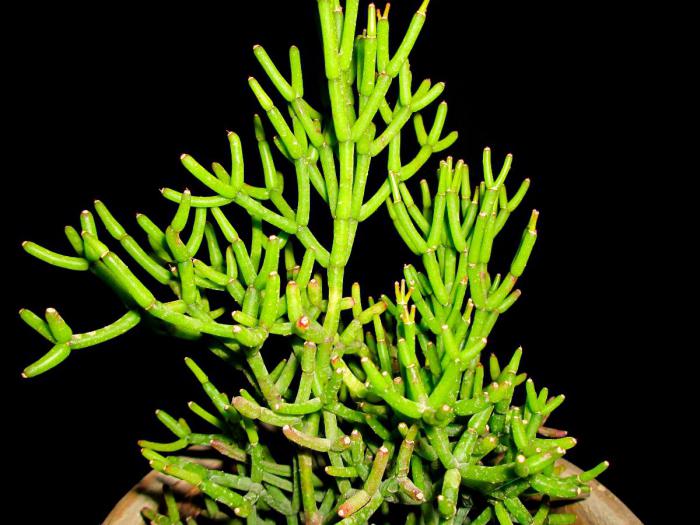

Hatiora is a plant belonging to the cactus family. Most often it grows on tree trunks, although in mountainous areas you can also find it on sheer cliffs. An unusual plant from Brazil found its place among the collections of amateur flower growers and quickly became one of the pets. The name was given in honor of the English cartographer who was engaged in mapping the area of South America, or rather, it is an anagram to his name.
Some time after his death, an expedition set out on his maps to the tropics, which discovered an amazing flower that vaguely resembles a cactus, but without sharp needles and numerous pimples, instead of them barely noticeable light bristles. Over time, many of its species were discovered, which received the most different and surprising names due to the bizarre external shape of the stem and twigs - coral cactus, "Drunkard's Dream", "Dancing Skeleton".
How to propagate by cuttings
Hatiora can be propagated by seed, but the simplest and fastest way is by cuttings. To do this, you need to wait for the period when the bush fades. Hatiory cuttings easily take root both in water and in soil. To carry out the procedure, it is enough to pinch off 2–4 upper segments from the trunk, treat the edge with charcoal (in the absence of it, you can also use simple activated carbon).
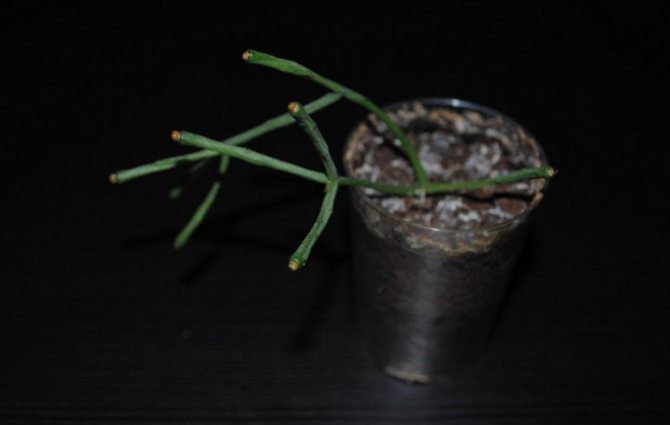

If you choose the method of germination in water, then immediately place the cutting in a transparent glass or other transparent container so that the water only covers the roots, then place the glass on a light windowsill, protecting it from direct sunlight.
Within a week, the cutting can take root. When its length reaches 2 cm, you can transplant the shoot into the ground.
Important! With the earthen method, after coal treatment, it is imperative to let the cutting dry
within 1-2 days andonly then plant in prepared soil. Sometimes even the segments used in the pruning can be used for grafting.
Taking root when planting in the ground occurs within 2-3 weeks. With the method of planting seeds, you need to wait for a dormant period and sow them in airy loose soil, covering only with a thin layer of earth, and cover with a film on top, thus arranging a greenhouse. Seedlings should be watered with warm water mixed with coal in the pan of the pot. This technique should be used until the seeds are fully germinated and rooted.
Care features
Caring for this succulent at home is not very difficult, so anyone, even a novice florist, can grow it.
Top dressing
Regular and balanced nutrition provides the flower with decorative effect throughout the year.
Fertilizers are applied during the period of active growth and in the flowering phase. Mineral feeds with a low nitrogen content and no calcium are used.
The optimal proportions are phosphorus 18 g, nitrogen - 9 g, potassium - 24 g. The dry components are dissolved in water according to the instructions.
They are introduced according to the following scheme - once every 14 days, then watering is carried out in order to improve the quality of absorption of nutrients. In the resting phase, when the indoor succulent has shed its last buds, it is stopped feeding.
Watering
This plant loves regular but moderate watering, so it is moistened only as the soil dries to a depth of 4-5 cm.Use settled or filtered water at room temperature.
In the winter season, the frequency is reduced to once every three weeks. After each watering, when the soil has absorbed moisture, the liquid accumulated in the pan is drained. It is better not to add to the hathior than to pour it over. From frequent waterlogging, the root system suffers and quickly decays.
The next day, surface loosening is carried out so that the soil remains light and passes moisture well in the future.
Transfer
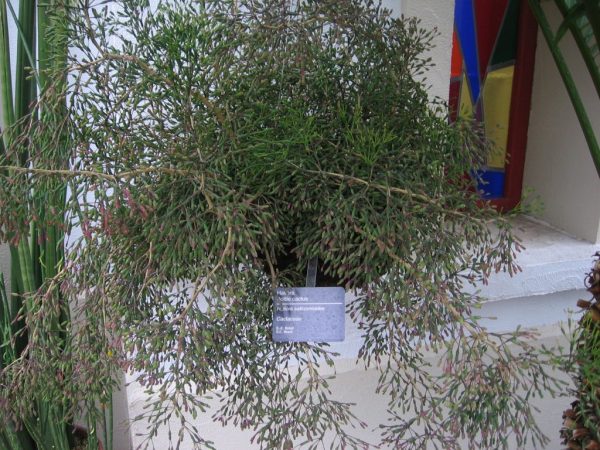

The flower can be transplanted in the dormant stage.
Flowers purchased at the store cannot be kept in the purchased land for a long time. It does not contain nutrients and plants can wither over time. It is not recommended to transplant a blooming hathiora, as it may not survive stress and will die.
After waiting for the end of flowering, they take a container 2-3 cm in diameter larger than the previous one, fill it with drainage, then with fertile soil used when planting a third of the volume.
The flower is watered abundantly in order to facilitate the extraction procedure and prevent injury to the roots, moved by the transshipment method, and then the soil is poured to the top, tamped and watered.
At home, the procedure is carried out every three years. An unscheduled transplant is required for a specimen whose root system has rotted or has been affected by harmful insects and diseases.
Pruning
Basic home care for a decorative cactus includes a yearly haircut. This plant can be given a beautiful appearance and density with regular pruning in the spring. The formation of the bush consists in pinching off the extra segments on the stems.
Some growers create a bonsai-shaped crown. This method is suitable for flowers with erect shoots. In early spring, the adjacent branches are removed from the lower part of the central trunk, gradually rising to the top. The upper stems are pinched to stimulate the formation of new processes.
To avoid infection, sprinkle with a fungicide after each pinching.
A sanitary haircut is also required in the spring: all dubious ones are cut off - yellowed, dry or decayed organs. At the end of flowering, dried inflorescences are cut off.
Flowering period
Many growers who grow this plant face a problem when it does not bloom or forms a small number of inflorescences.
There are two reasons for this - improper care during the rest period or too tight a container. In the cold season, you need to keep it cool (temperature 10-16 ° C), exclude all fertilizing and water every three weeks.
Subject to these rules, the Decembrist will delight you with lush and bright flowering.
Reproduction methods
Cuttings
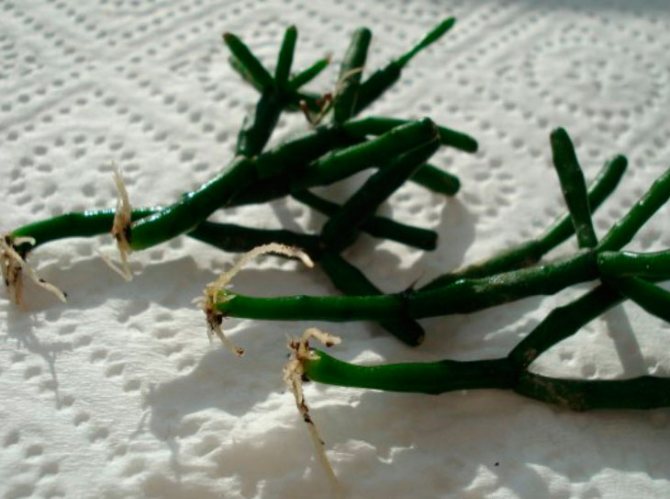

Indoor hathiora can be propagated very easily and quickly by cuttings. Any segment broken off from the stem can be used as a cutting, and it can give roots right there in a pot next to the parent bush. In order to propagate the flower in this way, when it fades, 3 or 4 segments are carefully unscrewed from the shoot. In the resulting cutting, you need to treat the wound with crushed charcoal and let it dry in the open air for 3-5 days. Then the lower part of the segment is sprinkled with Kornevin and planted for rooting in a moistened soil mixture. Watering the cuttings is carried out only when the soil mixture is completely dry, while moistening it through the pan (bottom watering). If you properly care for a young plant, then the next year it will bloom.
Graft
For vaccination, hatiors use peresky prickly. This procedure is carried out in the summer. Trim the branched part of the rootstock and then split the stem. A hatiora cuttings used as a scion should have 2 or 3 segments. Its lower part should be sharpened with a wedge, after which it is installed in the split of the rootstock trunk, fix the grafting site with a plaster.It will be possible to remove the bandage only when the scion begins to grow. If, where the bush will be, the air temperature will be 18–20 degrees, then the scion can take root after 15–20 days. Those stems that grow below the grafting site should be cut off. Such bushes, propagated by grafting, bloom very profusely.
general information
Hatiora is an indigenous inhabitant of the rainforests of Brazil, where these shrubs are not uncommon and are found everywhere. It belongs to the genus of epiphytes that develop on trees, but there are also several lithophytic varieties that grow in rocky gorges.
Apartment huts are small bushes, the height of which does not exceed half a meter. Whereas in nature they grow up to a meter.
It is difficult to imagine, but their closest relatives are cacti, and despite the external dissimilarity, there is quite a lot in common between them. Actually, for lovers of cacti and succulents, the cultivation of hatiors does not raise any questions, since these "green pets" require almost the same care.
It is interesting! The plant got its name thanks to Thomas Harriott, who makes maps of South America. Botanical scientists used them during expeditions and, having discovered the first succulents, came up with an anagram name for their genus, composed of the name of the cartographer. Subsequently, Ripsalidopsis and Ripsalis became representatives of separate genera, while the rest of the varieties united into one genus - hatiora.
Flowering period and features
Hatiora blooms, as a rule, for a long time and abundantly in winter. This is the main feature of this exotic representative of the cactus family. This is also preceded by a certain period in which a little effort is needed.
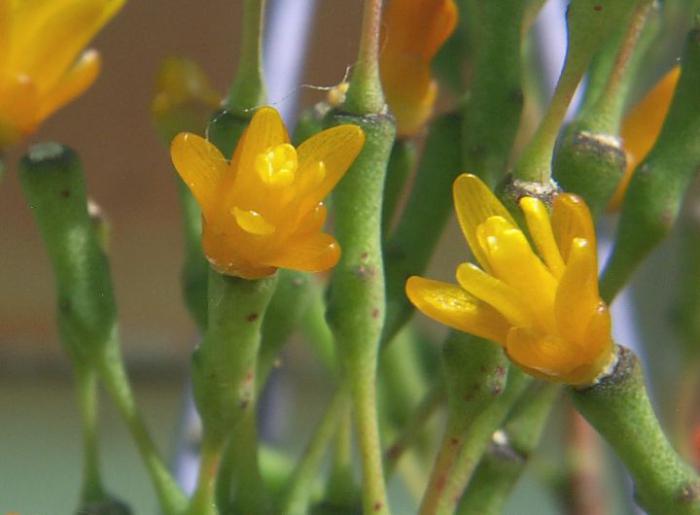

The active period of preparation for flowering begins in the summer. New segments are formed on the stems, on which buds will appear. Autumn for a hatior is a period of rest. Its growth slows down, the branches gain strength and nutrients for the appearance of buds. At this time, it is recommended not to water the flower or disturb it. The temperature is kept to a minimum and he is moved to a cooler place for about a month. Then they return to their original place and resume watering and feeding. At the beginning of winter, after such simple manipulations, buds appear at the ends of the branches, which will soon bloom and bloom magnificently. In the spring, there is a period of rest and recovery again.
Possible growing difficulties
Hatiora is also susceptible to various diseases, which can lead to a lack of flowering, decay of segments, drying out and necrosis of the shoots.
Why does not it bloom
Lack of flowering is the first signal that the flower is being kept in the wrong conditions.
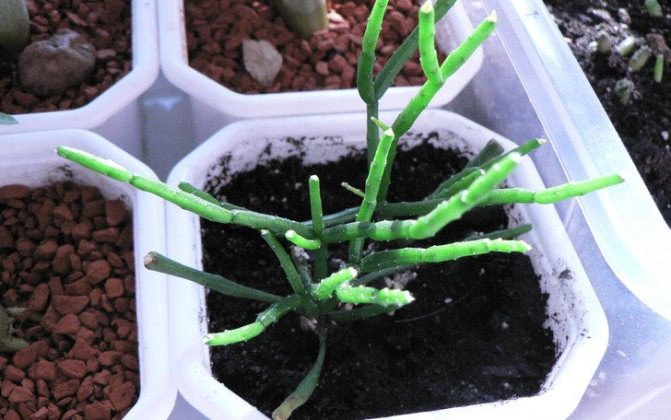

The reasons may be as follows:
- The pot is too small, and the root system of the cactus does not have enough room to develop. Try replanting the cactus in a wider pot and observe how the plant behaves.
- Unsuitable soil. Flowering may be absent due to the lack of necessary trace elements and minerals, most of which the plant receives from the soil. Replace the potting medium completely. To do this, carefully remove the cactus, clean the pot of soil residues, rinse it, dry it and plant the plant in a new substrate.
- Incorrect maintenance during the rest period. Flower buds are laid during the dormant period (from the end of November to February), so at this time it is especially important to provide the cactus with the necessary care and observe climatic conditions, humidify the air and adhere to a rare watering regime.
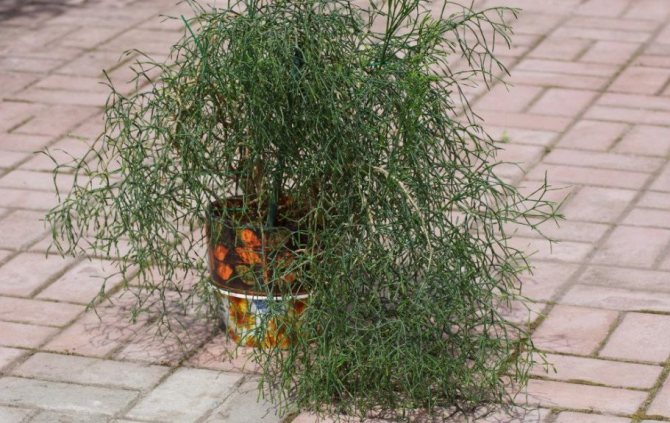

Diseases and pests
Among the possible diseases that the hatiora cactus is susceptible to, one can distinguish:
- Fungal diseases. Late blight can occur due to chronic waterlogging of the soil. In this case, the plant looks lethargic, soft and discolored.Due to abundant watering, the root system rots, and gradually this process spreads to the rest of the cactus. A disease such as fusarium affects open and untreated plant wounds, breaks, and can also spread due to insect bites in plant slices. In both cases, it is recommended to transplant the hathiora into new soil and apply fungicides that fight fungal diseases. These can be drugs such as Amistar Extra, Ridomil Gold, Flint Star and others.
- Bacterial infections. If you notice wet slippery spots on plant areas, this is the first signal that a cactus is infected with a bacterial infection. To do this, you immediately need to cleanse the hathiora from the affected segments, since the disease quickly spreads and affects the entire plant. Additionally, it is necessary to replace the topsoil. If you notice the symptoms too late, then the plant cannot be saved. The only way out is to prune still healthy cuttings to grow new plants.
- Damage by pests. Hatiora can be affected by mealybugs, scale insects, whiteflies, spider mites. The hatiora bush is most susceptible to the negative effects of insects in the summer. The first indicator of a lesion is yellowing of the segments, their flabbiness. The buds and stems dry out and fall off over time. In this case, you need to transplant the hathiora into new soil by treating the pot with boiling water and cleaning the old soil well. In addition, insecticides are used, for example, Floristin spray, Aktofit, Aktara, Aktoverm, Fastak, Lepidocyte and others.

